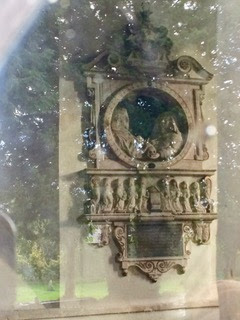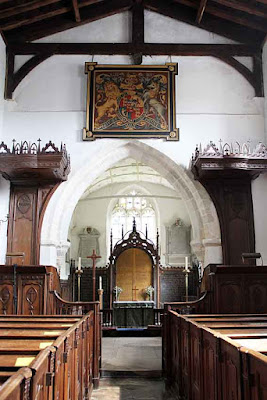Yesterday, for the first time in a year and more, I was out walking with that little band of walkers who, from time to time, muster for a day's walk, usually with some architectural/historical interest thrown in. I've been walking with them for nearly 40 years now, and the group is dwindling in numbers and becoming less active, for obvious age-related reasons – but yesterday five of us still ambulant survivors assembled in the Wiltshire countryside for a nine-mile walk, punctuated by the traditional long lunch.
We met at the out-of-the-way village of Ogbourne St Andrew, close to Marlborough but feeling much like the middle of nowhere. The church there, built of flint and ashlar with some brick infill, is a nice example of the kind of small, unostentatious village church that has evolved over the centuries, incorporating something of each architectural period along the way. It even has an Anglo-Saxon burial mound standing conspicuously in the churchyard – something you don't often see.
Sadly, but not surprisingly, the church was locked, but, peering in through a clear window, I was able to make out a rather fine monument, which I photographed through the glass, creating this ghostly image of a monument floating amid reflected trees and sky –
The other notable church was St John the Baptists, Mildenhall (pronounced Minal, and not to be confused with Mildenhall in Suffolk). This has a similarly unshowy and mixed exterior, but inside is a revelation – a rare, perfectly preserved late Georgian interior, complete with box pews, panelling, gallery, reredos, pulpit and (identical) reader's desk. And it was open.
We ate lunch in a little town pub in Marlborough, where the menu consisted almost entirely of pies – but they were good pies. As we ate – in company with another of the walkers and his wife, who had dropped in to meet us – we watched the rain siling down outside. By the time we had finished, it had passed over, replaced by blue skies and mellow autumn sunshine. Most of the rest of the walk was along an abandoned railway track, lined with small trees and shrubs – dogwood, guelder rose beautiful in its autumn colouring and hung with berries, hawthorn jewelled with bright red haws, blackthorn studded with plump sloes (abundant this year, as are most tree fruits).
It was so good to be out walking amid all this beauty, and in company again. Let's hope it is a harbinger of better, more normal, more humanly convivial times ahead.



Your blog is a sustaining joy. Thank you.
ReplyDeleteWell thank you, Unknown. Writing it is often a sustaining joy too.
ReplyDelete